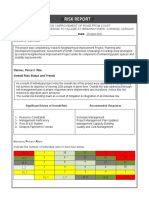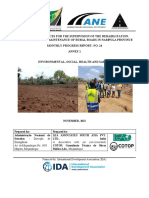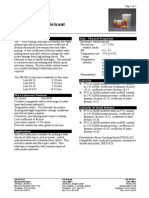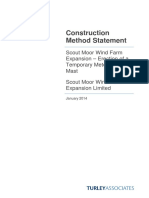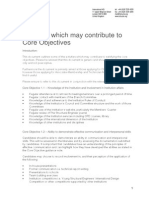Risk Assessment in Roadworks
Risk Assessment in Roadworks
Uploaded by
Jared MakoriCopyright:
Available Formats
Risk Assessment in Roadworks
Risk Assessment in Roadworks
Uploaded by
Jared MakoriOriginal Description:
Copyright
Available Formats
Share this document
Did you find this document useful?
Is this content inappropriate?
Copyright:
Available Formats
Risk Assessment in Roadworks
Risk Assessment in Roadworks
Uploaded by
Jared MakoriCopyright:
Available Formats
Journal of the Eastern Asia Society for Transportation Studies, Vol. 6, pp.
3971 - 3984, 2005
QUANTITATIVE RISK ANALYSIS OF ROAD PROJECTS BASED ON EMPIRICAL DATA IN JAPAN
Yukiya SATO Engineer Management Service Division, Chodai Co., Ltd. 1-20-4, Nihonbashi-Kakigaracho,Chuo-ku, Tokyo, 103-0014 Japan FAX: +81-3-3639-6805 E-mail: sato_yukiya@chodai.co.jp Kazuaki MIYAMOTO Professor Faculty of Environmental and Information Studies, Musashi Institute of Technology 3-3-1 Ushikubo-nishi,Tuzuki-ku, Yokohama, 224-0015 Japan Fax: +81-45-910-2593 E-mail: miyamoto@yc.musashi-tech.ac.jp Abstract: In a road project, there are various risks in each project stage. From the viewpoint of project management, it is essential to qualitatively analyze the risks and conduct the risk management. However, in reality, the data for the analysis is usually very limited in the countries and areas in Eastern Asia. The aim of the present study is to conduct quantitative risk analysis based on real data in road projects in Japan and discuss the risk management. Based on the obtained data, the frequency and the impact of each event are analyzed and summarized in a risk ranking matrix. In addition, arrow diagrams are built to represent the sequence of project steps. By translating the arrow diagrams to Monte Carlo simulation system, some model projects are simulated. The simulation results show several important implications such as management strategy based on the possibility of each pass to become the bottle neck. Key Words: road project risk, risk management, empirical analysis, 1. INTRODUCTION Social capital development projects, including road projects, are subject to various risks throughout their life cycle, from the planning and construction stage to the maintenance stage, due to long construction and maintenance periods and wide geographical coverage. For the proper execution of such projects, it is essential to quantify these risks for their appropriate management. Even though a quantitative risk analysis technique has been established through a series of studies 1), the probability of each risk, amount of damage and other data are required for actual risk analysis. In the UK, DBFO (design, build, finance and operate) offers the first step for the formulation of PFI projects and data for risk analysis is said to have been accumulated over a period of 30 years. Meanwhile, in East Asia in particular, there have been hardly any projects of which the planning involves the qualitative analysis of various risks throughout the life cycle, from the planning stage and construction stage to the maintenance/management stage in the postKeiichi KITAZUME Associate Professor Department of Civil Engineering, Kansai University 3-3-25 Yamate-cho, Suita, 564-8680 Japan FAX: +81-6-6368-0892 E-mail: kitazume@ipcku.kansai-u.ac.jp
3971
Journal of the Eastern Asia Society for Transportation Studies, Vol. 6, pp. 3971 - 3984, 2005
completion period. The period from the planning stage to the construction stage in particular faces many risks, including the difficulty of purchasing land and design alterations necessitated by external factors. As these can significantly affect the length of the project period and project cost, they must be clearly identified. Needless to say, risk avoidance or reduction measures based on past experience are employed for any project but it is also a fact that the more comprehensive and efficient handling of potential risks is essential in consideration of the tight fiscal situation and complicated social environment in the coming years. At present, however, hardly any risk data which forms the basis for such handling exists. Efforts to obtain risk data along the process of a specific project appears to be unrealistic because such a project is still in progress or it is difficult to retrospectively study the risks of past projects. Against this background, the present study proposes a desirable way to conduct a questionnaire survey as this type of survey allows the effective and efficient gathering of data for a project in progress. In addition, the study presents the results of basic risk analysis in line with the assumed typical road project processes. For this analysis, risk data for the various processes of recent road projects was gathered by a questionnaire survey using the newly designed survey technique and the risk data identified for each project stage was distributed along the said typical processes. The overall purpose is to show that the acquisition of risk data is highly significant for the comprehensive and efficient handling of risks. 2. BASIC CONCEPT OF RISKS FACED BY ROAD PROJECTS While the concept of risk has been introduced in various fields in recent years, the actual concept of such risk differs from one field to another without a common definition. In the fields of insurance and economics where studies on risks have a long history, a risk is defined as a change of a result which could occur during a specified period under specified conditions 2), uncertainty regarding the actual occurrence of a thing 3) or an object for insurance. The concept of risk debated in connection with the risk management theory is largely classified into the following three categories. a. Risk is the chance of loss b. Risk is the possibility of loss c. Risk is an uncertainty In addition to these, the word risk has other meanings, such as peril and hazard, etc. Having considered such debate, risk in social capital development is defined in this study as a factor of change causing a social loss as a result of impeding the achievement of a goal. This definition is based on the understanding that there is no special need to separately consider these three categories of risk as the risks in social capital development tend to be a mixture of these three categories of risk. Various elements of risks are believed to be mutually linked. For example, a phenomenon originates from multiple potential factors, multiple phenomena originated from a single
3972
Journal of the Eastern Asia Society for Transportation Studies, Vol. 6, pp. 3971 - 3984, 2005
potential factor or the occurrence of one phenomenon leads to the occurrence of another phenomenon. To clarify the causal relationship of risks, it is assumed in this study that a risk consists of three elements, i.e. factor, event and impact. Factors are phenomena which are potential causes of impeding the achievement of a goal. Concrete examples are economic changes, natural disasters and changes of the traffic volume, etc. Events as the direct causes of impeding the achievement of a goal with a certain probability originate from these factors. Concrete examples are difficulties in land acquisition negotiations, increased volume of rehabilitation work and increased maintenance work. As a result of an event(s), an impact occurs. Concrete examples are prolongment of the project period and increase of the project cost. These three types of phenomena are linked in the manner of a chain as shown in Fig. 1. It is feasible that event Ea caused by factor Fa becomes factor Fb for another event Eb. Equally, one factor Fc can cause multiple events Ec1 and Ec2, etc. while one event Ed is caused through the interaction of multiple factors Fd1 and Fd2, etc. The breakdown of risks with complicated links into three elements, i.e. factor, event and impact, makes it possible to establish a clear link between the elements and proper understanding of the risk in question.
Fc
Ec1
Ic1
Ec2
Ic2
F Factor
Fd1 Ed Id
E Event I Impact
Fd2
Fa Ea
Fb
Ia
Eb
Ib
Time
Figure 1. Correlation Diagramme of Three Elements of Risk
3. RISKS BY DIFFERENT PROJECT STAGE A road project involves a number of stages, from initial conceptualisation to preliminary study, surveying, designing, design consultation, negotiations on land acquisition, construction work and opening. As the risks at each of these stages differ, they must be properly identified and classified. A study was conducted on the basis of the classification shown in Table 1 which refers to the existing classification in RAMP 4) published by the Institution of Civil Engineers of the UK. Here, five stages, i.e. surveying and designing, design consultation, land purchase, construction work and post-opening, are adopted and various events are believed to occur due to six categories of factors at each stage. These factors are social, economic, administrative, natural, technological and formulation of a consensus. The mutual relationship between such risk elements as the case where an event taking place at one stage constitutes a factor at another stage mentioned earlier can be clearly understood based on these classifications.
3973
Journal of the Eastern Asia Society for Transportation Studies, Vol. 6, pp. 3971 - 3984, 2005
Table 1. Classification Adopted by the Study
1Social Development Plan Cultural Assets Split of Local Communities 2Economic Interest Rate/Foreign Exchange Rate Budgetary Measure Inflation/Deflation Contraction/Expansion of Economy 3Administrative Change of Plan Consultation on Farmland Cost Reduction Consultation on Connecting Roads Consultation with Organizations Concerned, etc. 4Natural Natural Scenery Environment Technological Innovation Geological Conditions Disaster, such as Earthquake or Typhoon Change of Design/Construction Method 5Technical Loss Environmental Issues Accident Buried Structure Work in the Vicinity 6Consensus Undefined Boundaries Opposition to Project Objectives Unit Price of Land, etc. Others
I Surveying and Designing
II Design Consultation
Repeated work due to a change of the route Repeated work due to a change of the structure Others Prolonged consultation on environmental measures Prolonged consultation on route and/or structure Prolonged coordination with the organizations concerned (agricultural policies and urban planning, etc.) Prolonged consultation on new development plan (new town, etc.) Prolonged consultation on natural environment Prolonged consultation on buried cultural assets Others Delay due to refusal of entry for surveying Delay due to dificult settlement of boundaries Delay due to unit price negotiations Delay due to an administrative factor, such as budget cut Others Suspension or delay due to impact of the work on local communities Suspension or delay due to an accident (landslide, etc.) Suspension or delay due to environmental measures Shortening or delay due to an unexpected change of the geological conditions Suspension or delay due to the unexpected discovery of a buried structure Shortening or delay due to measures for adjacent structures Suspension or delay due to the new discovery of buried cultural assets Supension or delay due to a natural disaster (earthquake, typhoon or other) Delay due to an administrative factor, such as budget cut Others Decrease or increase of the traffic volume due to a change of the socioeconomic situation Rehabilitation of accidental damage (landslide, etc.) Environmental measures Compensation for adverse impacts of a new road on local communities Remodelling through coordination with the organizations concerned Rehabilitation of damage due to a natural disaster (earthquake, typhoon or other) Others
III Land Purchase
IV Construction Work
V Post-Opening
4. FACT-FINDING SURVEY ON ORDINARY NATIONAL ROAD PROJECTS 4.1 Outline of Fact-Finding Survey 4.1.1 Survey Subjects The subjects of this fact-finding survey were 86 nationwide offices of the Japanese Ministry of Land, Infrastructure and Transport. Two target work blocks at different stages out of four stages, i.e. I: surveying and designing, II: design consultation, III: land purchase and IV: construction work, were selected from among road projects currently in progress by each office. In addition, one route was selected for each office. The selection criterion for such work block or route was the difficulty of maintaining the original plan because of the occurrence of various events. A 100% survey or random sampling is necessary to give the analysis results general applicability. However, a 100% survey is unrealistic while random sampling may not provide the type of data required. Accordingly, the samples for this survey were selected based on a major divergence from the original plan. The results of this survey are, therefore, the risks which are likely to be encountered by road projects and the impacts of such risks once they occur. These results must be interpreted taking the fact that there are many projects which are little or not affected by many risks not considered by this survey into consideration. 4.1.2 Survey Items The survey items are classified into the following three categories. a. Project cost: planned (estimate at the time of project commencement) and actual b. Project period: planned (estimate at the time of project commencement) and actual c. Types of events which were difficult to deal with in the last three years and factors,
3974
Journal of the Eastern Asia Society for Transportation Studies, Vol. 6, pp. 3971 - 3984, 2005
scales, impacts and remedial measures regarding such events Up to the present, risks causing the divergence of the project cost and/or project period from the originally planned cost and/or period have not been clearly identified. For this reason, the fact-finding survey under the study was designed to focus on events which were easy to directly observe based on the risk structure discussed in 2. Firstly, the respondents of the questionnaire were asked to name an event which had actually taken place at each stage. As such event was something they had found difficult to deal with, it was easy for the respondents to name it. Next, the respondents were asked to select a factor causing the event in question from the alternatives given. By providing alternatives which included all possible factors, the respondents could select an alternative of which they were initially unaware. Finally, the respondents were asked to answer how much the project cost as well as project period had increased due to the occurrence of the event in question. 4.1.3 Criteria for Impacts For quantification of a delay in the project period and excess in terms of the project cost as the impacts of an event. The difference (divergence) between the reference value and the actual value is defined as the quantity of impact. Here, there can be four types of reference values as listed below. a. Standard values: The average value of something and the expected value can be considered the standard value. A value which is assumed to be the common value based on past experience may also be the standard value. As what constitutes the criterion is unclear, roughly half of the projects are deemed to be delayed and to overshoot the original budget. b. Shortest values/lowest values: These represent the period and cost required to complete the work provided that the work smoothly progresses at all stages. As the ideal project period greatly varies depending on the various factors involved, it is difficult to determine the objective as well as rational period or cost. c. Announced values: The period and cost with which the probability of project completion is fairly high are judged from the viewpoint of the project implementer for individual projects, taking the various conditions and characteristics of the locality into consideration, and are publicly announced. It is believed that the general public plans its daily activities using these values as yardsticks. Divergence from these values affects national life and company activities. However, the objective decision-making mechanism is unclear as the values may be biased towards an excessive safety margin. Moreover, a change of value may occur more than once with the progress of a project. d. Optimal values: The period and cost with which the net socioeconomic benefit becomes the largest from the viewpoint of the entire society. It is extremely difficult to set up these values under many restrictive conditions. Given the above argument, while optimal values are ideally desirable for society, it is extremely difficult to infer such values. Meanwhile, although the process of setting up
3975
Journal of the Eastern Asia Society for Transportation Studies, Vol. 6, pp. 3971 - 3984, 2005
announced values is unclear, these values are easy to adopt to seek the public fs understanding for public works. For this reason, the announced values at the beginning of a project are used as the reference values for analysis in this study. 4.2 Questionnaire Results for National Road Offices Nationwide 4.2.1Excess by Cost Item Here, the divergence of the actual cost from the planned total project cost is examined instead of the impact of each event on the cost. As the total project cost greatly varies depending on the scale of a project, this divergence is expressed as a percentage of the actual cost to the planned cost. Fig. 2 shows the frequency distribution of the total project cost. There are cases where the actual cost is less than 100% of the planned cost, presumably reflecting the inclusion of the cost of dealing with risks in the planned cost. While the average value exceeds 150%, the mode and median are 100% and approximately 130% respectively. As the samples in this study are projects which have encountered a difficulty of dealing with events, an excess cost is likely to occur compared to common projects. While most projects are in progress in line with the planned cost, those showing the largest divergence from the planned cost are spending more than 10 times the planned cost.
70 60 50 Frequency 40 30 20 10 0 0-50% 50-100% 100-150% 150-200% 200-250% 250-300% 300-350% 350-400% 400-450% 450-500% 500-%
Figure 2. Ratio of Actual Project Cost to Planned Total Project Cost 4.2.2 Excess Period by Project Stage Like the cost, the divergence of the planned period from the actual period is examined for each stage of the road projects. Fig. 3 shows the frequency distribution of such divergence, indicating that an average delay of 3.8 years in the period from the surveying and designing stage to opening has occurred. The mode is 0 years, indicating that many projects are progressing in accordance with the original plan.
3976
Journal of the Eastern Asia Society for Transportation Studies, Vol. 6, pp. 3971 - 3984, 2005
30 25 20 Frequency 15 10 5 0 0 1 2 3 4 5 6 7 8 9 10 11 12 13 14 15 16 17 18 19 20 21 22 23 Difference between Plan and Result (Years)
Figure 3. Difference Between Plan and Result 4.3 Risks of Ordinary National Road Projects The analysis in 4.2 is conducted without identifying the risks. Here, each risk is analysed in terms of its factors, events and impacts. 4.3.1 Relationship Between Factor and Event To establish the relationship between a factor and event, the frequency of occurrence by event and factor at each stage is shown in Table 2. At the surveying and designing stage, the event of repeated work due to a change of the structure occurs with more than 60% of the projects. Some 30% occurs due to the factor of a change for cost reduction, suggesting strong motivation for cost reduction. Another frequently occurring event is repeated work due to a change of the route with some 20% of the projects and the factor of the discovery of a valuable cultural asset is responsible for half of this event. At the design consultation stage, the events of consultation on environmental issues, consultation with local communities on the route/structure and coordination with the organizations concerned occur with some 20% of the projects. Of these, consultation on environmental issues and consultation with local communities are mainly caused by the factor of a split of local communities. Another event of consultation on buried cultural assets occurs with some 10% of the projects, indicating the fact that events involving cultural assets occur at different stages. At the land purchase stage, the event of difficulty in land purchase negotiation occurs with nearly all of the projects. Even though the samples in this study are selected based on the condition of experiencing difficulties in dealing with a problem(s), the almost universal occurrence of this event cannot be simply ignored. Many factors appear to be involved in this event. At the construction work stage, many projects must respond to problems in the surrounding area but these problems can be avoided by prior proper management. Also at this stage, an event occurs due to the discovery of buried cultural assets.
3977
Journal of the Eastern Asia Society for Transportation Studies, Vol. 6, pp. 3971 - 3984, 2005
Table 2. Occurrence Rates of Events and Factors by Project Stage
3978
Journal of the Eastern Asia Society for Transportation Studies, Vol. 6, pp. 3971 - 3984, 2005
4.3.2 Relationship Between Event and Impact The relationship between an event and impact is analysed next. Table 3 shows the impacts of an event at various project stages. In this table, only those impacts with a concrete numerical value (including 0) are included in a number of cases, excluding those where the impact of an event cannot be quantified despite the occurrence of such event. Among those events of which there are many cases, events causing a large impact are repeated work due to change of the route at the surveying and designing stage, consultation on environmental measures and consultation with local communities on the route/structure at the design construction stage. As these events occur at the relatively early stages of a project, any delay in these stages is believed to affect the work in the succeeding stages, indicating the importance of proper management from the early stages. At the land purchase stage, the difficulty in land purchase negotiation causes an average delay of 2.3 years. Given the fact that this event occurs with almost all projects, the factors for this event appear to be strongly responsible for a delay of project completion. In regard to impacts on the total project cost, the event of repeated work due to change of the structure shows a negative value on average. This is primarily due to the fact that this event occurs because of the factor of change for cost reduction. None of the individual events at the design consultation stage and construction work stage show an excess of much higher than 5% of the planned total project cost but the combined effect of these effects appears to be responsible for the major cost excess of each project. Table 3. Impacts by Event
4.3.3 Risk Ranking Matrix At a stage where risks are identified, all of the risks impeding the achievement of the project goals are included. As the compilation results in Table 3 show, however, some risks have an extremely low probability of occurrence while others hardly affect a project. For the purposes of project implementation, it is essential to pay attention to those risks which are likely to affect a project. Here, risks are classified into four ranks regarding their probability and impact based on the compilation results in Table 3. Each rank is then given a range of values. Table 4 and Table 5 are the ranking matrix of events in terms of impact on the project period and project cost respectively. For example, the risk (event) of difficulty in land purchase
3979
Journal of the Eastern Asia Society for Transportation Studies, Vol. 6, pp. 3971 - 3984, 2005
negotiation (III-1) has both a high level of probability of occurrence and strong impacts and, therefore, demands special attention when planning a road project. In contrast, the risk (event) of change of social conditions (III-3) is not prominent in both aspects. Table 4. Ranking Matrix (Impact on Project Period)
3 Impact(Period) 2 1 0 48 1 13 21 63 4 5 27 21 6 35 29 10 0 1 2 Probability of Occurrence 3
Table 5. Ranking Matrix (Impact on Project Cost)
3 Impact (Cost) 2 1 0 16 56 9 21 23 23 11 7 3
35 4 2 10 48 0 1 2 Probability of Occurrence
5. QUANTIFICATION OF RISKS BY SIMULATION 6.1 Risk Analysis Following Project Implementation Processes The typical project implementation processes shown in Fig. 4 were assumed and case studies on the impacts were conducted by applying the ranking matrix of risks (events) to the assumed processes. Firstly, a project period disregarding the risks at various project stages was set up and the possible risks at each stage were allotted to the relevant processes. The risks at the surveying and designing stage were allotted to J, the risks at the land purchase stage to O and P and the risks at the construction work stage to Q and R. The exceptions were the risk (event) of II-6 allotted to B and L and the risk (event) of IV-3 allotted to C and M. Using the Monte Carlo simulation technique, the total project period considering the risks was quantified based on the assumed project processes.
3980
Journal of the Eastern Asia Society for Transportation Studies, Vol. 6, pp. 3971 - 3984, 2005
A
Survey on Buried Objectives
B
Consultation
C
Relocation of Buried Objectives
D
Surveying Explanation of Copensation Decision on Alignment Site Investigation
O
Land Purchase Negotiation
Construction Work
P
Start of the Project
Land Purchase Negotiation Opening
G
Geological Survey
H
Outline Design
J
Design Consultation
N
Consultation on Construction Work Detailed Design
R
Construction Work
K
Survey on Buried Objects
L
Consultation
M
Relocation of Buried Objects
Figure 4. Project Flow 5.2 Establishment of Distributions Here, the distributions based on the probability of occurrence of each risk are established. The probability of occurrence of each risk is calculated by dividing the number of cases of each event by the total number of target work blocks. The average value and the standard deviation value of each event are then calculated and the types of distribution most suitable for the probability distribution are selected. Fig. 5 shows the probability distribution suitable for the impact of difficulty in land purchase negotiation (III-1) on the project period, which is the most prominent risk in this regard, as an example of the risk analysis results. Here, the probability of occurrence is 58%, the average impact is 0.57 years and the standard deviation is 2.40 years. Various types of distribution can be relevant for other risks as in the case of repeated work due to change of the structure (I-2). These include uniform distribution, Gumbel distribution and exponential distribution.
0.02
0.05 Probability 0.04 0.03 0.02 0.01 0 0.06 2.36 4.66 6.97 9.27 Impact(Years) Exponential Distribution
0.015 Probability 0.01 0.005 0 0.02 0.64 1.26 1.88 Impact(Years) Normal Distribution 2.50
Figure 5. Probability Distribution of Impacts
5.3 Simulation Results
3981
Journal of the Eastern Asia Society for Transportation Studies, Vol. 6, pp. 3971 - 3984, 2005
Table 6 is a scheduling table for one simulation exercise. The results of this simulation show that the probability of the project being completed within a planned project period of 10.5 years is 8.3%, that the project can be completed within 21 years with a probability of 80% and that the probability of becoming a critical path changes depending on the work processes involved. Table 6. Scheduling Table to Achieve Critical Path
Work A B C D G H J K L M N O P Q R Preceding Work A B G H K L J D,J D,J C,O,N M,N,P Period 0.20 0.20 1.18 1.00 0.50 1.50 0.50 0.20 0.20 1.00 1.20 7.89 7.95 3.00 4.00 Fastest Start 0.00 0.20 0.40 0.00 0.00 0.50 2.00 0.00 0.20 0.40 2.50 2.50 2.50 10.39 10.45 Fastest Slowest Start Completion 0.20 9.87 0.40 10.07 1.58 10.27 1.00 1.50 0.50 0.00 2.00 0.50 2.50 2.00 0.20 9.05 0.40 9.25 1.40 9.45 3.70 9.25 10.39 3.56 10.45 2.50 13.39 11.45 14.45 10.45 Slowest Margin Completion 10.07 9.87 10.27 9.87 11.45 9.87 2.50 1.50 0.50 0.00 2.00 0.00 2.50 0.00 9.25 9.05 9.45 9.05 10.45 9.05 10.45 6.75 11.45 1.06 10.45 0.00 14.45 1.06 14.45 0.00
A G K H
B D J L
C O P N M
Q R
Figure 6. Critical Path
6. CONCLUSIONS This study examines the real risks faced by road projects using actual data gathered from national road offices engaged in road projects and conducts risk analysis along the work processes of a project. The study findings are described below. a. Risks are interpreted as a chain of factors, events and impacts and the reality of risks is clarified using a risk matrix based on events which are easy to observe. Some events have a high probability of occurrence as well as strong impacts and, therefore, demand special attention when planning a road project. The possibility of efficient management by means of risk management based on the risk matrix is suggested. b. Individual risks are allotted to the project processes and the type of distribution suitable for each risk is established using actual data. The type of distribution differs from one risk to another as various types of distribution, including uniform distribution, normal distribution, exponential distribution and Gumbel distribution, etc., are relevant to certain
3982
Journal of the Eastern Asia Society for Transportation Studies, Vol. 6, pp. 3971 - 3984, 2005
events, suggesting the necessity to conduct risk analysis based on appropriate types of distribution. c. Application of the Monte Carlo simulation technique using the types of risk distribution obtained makes the quantification of risks along the project processes possible to a certain extent. The probability of an excess period and excess cost can be established in advance. The situation and changes of the critical path can also be established. The following problems can be pointed out when planning risk analysis using actual data. Firstly, there is a problem of the analytical unit to identify risks. In the case of road projects which are mutually related through a network, it is essential to conduct risk analysis for the entire network. However, each road project features a specific road section and there are risks which solely originate from the particular conditions of such section. Even if the available data is classified into unit work blocks as in the case of the present analysis, there is a possibility that the data in question does not reflect the diverse conditions of the unit work block and/or that the impacts from other work blocks are under-evaluated. Moreover, the establishment of project stages is not an easy task. In the case of continual road projects, even the starting point of a project is unclear. It is also possible that the surveying and designing, design consultation, land purchase and construction work stages progress while overlapping each other. The situation of risks in the sequential implementation of project stages may differ from the situation of risks in a project where the stages overlap each other. Furthermore, the study features up to the construction work stage, ignoring such important risks in the post-completion period as the risk related to the demand forecast and the risk related to environmental measures. The reason for omitting these risks is the lack of a sufficient number of replies to these risks in the questionnaire survey. This fact in turn appears to suggest the importance of clearly establishing and recognising the risks in the post-opening (operating) stage. It is essential to gather data and to conduct analysis regarding risk management at the operating stage after the completion of construction work. Despite these problems, it is believed that the study on risks using actual data for the road project processes provides many useful insights and suggestions to achieve comprehensive and efficient road project management. It is hoped that this study has initiated a process to establish a system which is capable of gathering much risk data so that quantitative risk analysis and project management based on such a system will become the normal practice.
3983
Journal of the Eastern Asia Society for Transportation Studies, Vol. 6, pp. 3971 - 3984, 2005
ACKNOWLEDGEMENT This paper outlines part of the Analytical Study of Risks of Road-Related PFI Projects entrusted by the Road Bureau of the Japanese Ministry of Land, Infrastructure and Transport to the Japan Society of Civil Engineers (JSCE). The author would like to express his gratitude to both bodies for the opportunity to participate in the said study.
REFERENCES a) Books and Books chapters Greene, M.R. (1968) Risk and Insurance, 2nd Edition, South-Western Publishing Company. RAMP, ICE (2000) Risk Analysis and Management for Projects (Ramp), Thomas Telford Ltd. Vose, D. (2000) Risk Analysis - a Quantitative Guide, John Wiley & Sons. Williams, C.A. and Heins, R.M. (1976) Risk Management and Insurance, McGraw-Hill Book Company.
3984
You might also like
- Graydon HallDocument5 pagesGraydon HallMUHAMMAD HAMZANo ratings yet
- Project EHS PlanDocument158 pagesProject EHS Plansumit solankiNo ratings yet
- EMP - Training - Periodic Maintenance WorkDocument27 pagesEMP - Training - Periodic Maintenance WorkRani Arun ShakarNo ratings yet
- Sheria Ya Jeshi La Zimamoto Na Uokoaji 2007Document22 pagesSheria Ya Jeshi La Zimamoto Na Uokoaji 2007Ahmed MakbelNo ratings yet
- A Brief Intellectual History of The Public-Private Partnership MovementDocument25 pagesA Brief Intellectual History of The Public-Private Partnership MovementIzet MahirNo ratings yet
- GIZ, Tullow and KMFB Technical Proposal 6.3.2017Document76 pagesGIZ, Tullow and KMFB Technical Proposal 6.3.2017Jay WhiteNo ratings yet
- ICE 3006A Continuing Professional DevelopmentDocument14 pagesICE 3006A Continuing Professional DevelopmentNicholas Omoding50% (4)
- Monthly Progress Report On Road Safety ActivitiesDocument17 pagesMonthly Progress Report On Road Safety ActivitiesAkshay Kumar SahooNo ratings yet
- Method Statement of Road Sub Base Amd BaseDocument7 pagesMethod Statement of Road Sub Base Amd BaseBrian Colon50% (2)
- Restoration PlanDocument16 pagesRestoration PlanadiNo ratings yet
- Construction Procedure Earth WorkDocument28 pagesConstruction Procedure Earth WorkDimas DzununNo ratings yet
- Safety Plan: A) Personal Protective Equipment (Ppe)Document4 pagesSafety Plan: A) Personal Protective Equipment (Ppe)Navneet SoniNo ratings yet
- Safety FileDocument36 pagesSafety FileAnonymous SVH04bUaNo ratings yet
- Risk Report-Road ConstructionDocument5 pagesRisk Report-Road ConstructionSyed Yasir Baqar Kazmi100% (1)
- 2022.11 Eshs MPR Ifrdp Nrr-Nampula N-14.NovemberDocument74 pages2022.11 Eshs MPR Ifrdp Nrr-Nampula N-14.NovemberMarcelino Adelino NivallNo ratings yet
- Traffic Rules and RegulationsDocument11 pagesTraffic Rules and RegulationsMarijoe PimentelNo ratings yet
- Back Filling Work Method StatmentDocument2 pagesBack Filling Work Method StatmentAbu Nijam100% (1)
- Project Title: TBA: Client: ContractorDocument5 pagesProject Title: TBA: Client: ContractorIzza HalimNo ratings yet
- A Copy of Sample Traffic Management PlanDocument20 pagesA Copy of Sample Traffic Management PlanIsr W. MekonnenNo ratings yet
- c1-10 Demolition and Site ClearanceDocument25 pagesc1-10 Demolition and Site ClearanceJacky TiongNo ratings yet
- TOR For Route-Geo - Calaca-Dasma500Document48 pagesTOR For Route-Geo - Calaca-Dasma500Faty BercasioNo ratings yet
- Demolition Method Statement For Building Structures or ServicesDocument2 pagesDemolition Method Statement For Building Structures or ServicesVen ZeaNo ratings yet
- Clearing and GrubbingDocument4 pagesClearing and GrubbingDevrim GürselNo ratings yet
- Groundwater Recharge SK SharmaDocument30 pagesGroundwater Recharge SK Sharmasweta jadhavNo ratings yet
- Final HighwayDocument39 pagesFinal HighwayKanabu EvansNo ratings yet
- S. I. 268 of 2018 Environmental Management Hazardous SubDocument78 pagesS. I. 268 of 2018 Environmental Management Hazardous SubMoleki NgendaNo ratings yet
- LFG Engineer - CVDocument2 pagesLFG Engineer - CVGökhan GökçeNo ratings yet
- MOS Change Road Kerb and SurfaceDocument6 pagesMOS Change Road Kerb and SurfacePrince Car-changNo ratings yet
- Midal Cables Method StatementDocument13 pagesMidal Cables Method StatementRICHARD FUNUENo ratings yet
- Construction Safety Audit ReportDocument2 pagesConstruction Safety Audit ReportsrinetsumitNo ratings yet
- DGPS SurveyDocument7 pagesDGPS Surveyvenugopal K PNo ratings yet
- Site Management and OrganizationDocument8 pagesSite Management and OrganizationCarlos Ramos GuerraNo ratings yet
- Chance Find ProcedureDocument16 pagesChance Find ProcedureOcheme Paul100% (1)
- Excavation and BackfillingDocument2 pagesExcavation and BackfillingyasserNo ratings yet
- Batching Plant Project: Initial Environmental Examination (Iee) ReportDocument16 pagesBatching Plant Project: Initial Environmental Examination (Iee) ReportavieNo ratings yet
- SAHPRA South African Health Products Regulatory Authority - UpdateDocument28 pagesSAHPRA South African Health Products Regulatory Authority - UpdateGabriel Opoku AduseiNo ratings yet
- ESMPDocument62 pagesESMPMunir HussainNo ratings yet
- ESMP Revised Road No 7Document144 pagesESMP Revised Road No 7Nisanth Thulasidas100% (1)
- Lifting PlanDocument4 pagesLifting PlanNeeraj DubeyNo ratings yet
- Standard Penetration Test PDFDocument13 pagesStandard Penetration Test PDFMohamedRaahimNo ratings yet
- Tower Safety PlanDocument10 pagesTower Safety PlanLimar SetatraNo ratings yet
- Construction Equipments Operations and MaintenanceDocument1 pageConstruction Equipments Operations and MaintenanceDanren BautistaNo ratings yet
- AbstractDocument5 pagesAbstractcity cyberNo ratings yet
- This Study Resource Was: Project in Civil Engineering Law, Contracts, Specifications, and EthicsDocument2 pagesThis Study Resource Was: Project in Civil Engineering Law, Contracts, Specifications, and EthicsCn cnNo ratings yet
- Road Safety AuditDocument21 pagesRoad Safety AuditAmardeep100% (1)
- Traffic Management PlanDocument1 pageTraffic Management PlanArif ZulNo ratings yet
- Msunduzi Application Form.Document5 pagesMsunduzi Application Form.SiyabongaNo ratings yet
- KHNKJH NCP 30 1Document31 pagesKHNKJH NCP 30 1djsouravNo ratings yet
- T.M.P ChecklistDocument4 pagesT.M.P ChecklistPhil BakerNo ratings yet
- How To Mail in A Formal WayDocument2 pagesHow To Mail in A Formal Wayaarambhikah 20No ratings yet
- G1 Draft Road Construction EMP R61Document31 pagesG1 Draft Road Construction EMP R61xbitmanNo ratings yet
- DRAFT SA MATOC Management ApproachDocument25 pagesDRAFT SA MATOC Management Approachdenys.castanedatNo ratings yet
- San Fernando Zoning - Chapter 2Document43 pagesSan Fernando Zoning - Chapter 2Ar. AizaNo ratings yet
- Method Statements 20 % Week 08-09Document10 pagesMethod Statements 20 % Week 08-09Sujani MaarasingheNo ratings yet
- Demob WithoutattachDocument5 pagesDemob WithoutattachBukan PeretasNo ratings yet
- Subcontractor and Subcontracting PlanDocument2 pagesSubcontractor and Subcontracting Planferdinand.ikejiNo ratings yet
- BSNL - Recruitment of Telecom Technical Asst For Himachal Pradesh Telecom CircleDocument14 pagesBSNL - Recruitment of Telecom Technical Asst For Himachal Pradesh Telecom CircleGN ReddyNo ratings yet
- Cable Pulling Lubricant - Data Sheet (En Ingles)Document2 pagesCable Pulling Lubricant - Data Sheet (En Ingles)angel de mi guardaNo ratings yet
- 1 Hse Management ResponsibilityDocument13 pages1 Hse Management ResponsibilityRATAN BHATIANo ratings yet
- 2014-0021 Construction Method StatementDocument15 pages2014-0021 Construction Method StatementrobconstantNo ratings yet
- My Days in Court: Travails and Hullabaloos in a UniversityFrom EverandMy Days in Court: Travails and Hullabaloos in a UniversityRating: 4 out of 5 stars4/5 (1)
- Quantitative Risk Analysis of Road Projects Based On Empirical Data in JapanDocument14 pagesQuantitative Risk Analysis of Road Projects Based On Empirical Data in JapanIrenataNo ratings yet
- Risk Assessment For Large Scale TransporDocument12 pagesRisk Assessment For Large Scale TransporMohamed BelalNo ratings yet
- Four Decades of Pavement Management: What We've Learned, Forgotten, or Never KnewDocument39 pagesFour Decades of Pavement Management: What We've Learned, Forgotten, or Never KnewJared MakoriNo ratings yet
- Roads V6.3: Reference ManualDocument330 pagesRoads V6.3: Reference ManualSOORI14No ratings yet
- Kerali PDFDocument15 pagesKerali PDFJared MakoriNo ratings yet
- Sewer V6.3: Reference ManualDocument173 pagesSewer V6.3: Reference ManualJared MakoriNo ratings yet
- STF-21 - Appendix 14 JICA Development Initiative (TKanenawa)Document16 pagesSTF-21 - Appendix 14 JICA Development Initiative (TKanenawa)Jared MakoriNo ratings yet
- STD Concrete Box Culverts Manual 2 - 1Document41 pagesSTD Concrete Box Culverts Manual 2 - 1Jared Makori88% (8)
- STD Small Span Concrete Bridges Part 1. - 1Document129 pagesSTD Small Span Concrete Bridges Part 1. - 1Jared MakoriNo ratings yet
- Moving Load AnalysisDocument3 pagesMoving Load AnalysisJared MakoriNo ratings yet
- STD Drainage Structures Part 2 Concrete Box CulvertDocument22 pagesSTD Drainage Structures Part 2 Concrete Box CulvertJared Makori80% (5)
- STD Concrete Box Culverts Manual 2 - 1Document41 pagesSTD Concrete Box Culverts Manual 2 - 1Jared Makori88% (8)
- STD Drainage Structures Part 2 Concrete Box CulvertDocument22 pagesSTD Drainage Structures Part 2 Concrete Box CulvertJared Makori80% (5)
- STD Drainage Structures Part 1 Small SpanDocument59 pagesSTD Drainage Structures Part 1 Small SpanJared MakoriNo ratings yet
- STD Drainage Structures Part 2 Concrete Box CulvertDocument22 pagesSTD Drainage Structures Part 2 Concrete Box CulvertJared Makori80% (5)
- STD Small Span Concrete Bridges Part 1. - 1Document129 pagesSTD Small Span Concrete Bridges Part 1. - 1Jared MakoriNo ratings yet
- CPWD Speci Civil 2009 Vol1Document544 pagesCPWD Speci Civil 2009 Vol1supriyo.podder100% (2)
- Xanthakos P. - Theory and Design of BridgesDocument1,460 pagesXanthakos P. - Theory and Design of BridgesShittu Abdulhakim100% (17)
- Xanthakos P. - Theory and Design of BridgesDocument1,460 pagesXanthakos P. - Theory and Design of BridgesShittu Abdulhakim100% (17)
- LRFD - Bridge Design ManualDocument801 pagesLRFD - Bridge Design ManualFidel ZuñigaNo ratings yet
- AppendicesDocument102 pagesAppendicesJared MakoriNo ratings yet
- Accounting Forum: Istemi Demirag, Iqbal Khadaroo, Pamela StapletonDocument13 pagesAccounting Forum: Istemi Demirag, Iqbal Khadaroo, Pamela StapletonHendra PoltakNo ratings yet
- NUS NEC Papers Set 2 For 17 SeptDocument118 pagesNUS NEC Papers Set 2 For 17 SeptEdmund R SchNo ratings yet
- Risk Assessment & RatingsESRM OfficerDocument2 pagesRisk Assessment & RatingsESRM OfficerBoyi EnebinelsonNo ratings yet
- Commonwealth Bank of AustraliaDocument6 pagesCommonwealth Bank of Australiatusharyourfriend2958No ratings yet
- Workplan Final Usaid 1 Year Workplan - Final 3.5.15Document2 pagesWorkplan Final Usaid 1 Year Workplan - Final 3.5.15rajan patelNo ratings yet
- Complete PHD FINALDocument489 pagesComplete PHD FINALÆm Đ Bøśš MùĺlerNo ratings yet
- ATM RAHAT MOHAMMAD - Passport ImageDocument37 pagesATM RAHAT MOHAMMAD - Passport ImageJony IslamNo ratings yet
- Hotel Budget Spreadsheet ExcelDocument16 pagesHotel Budget Spreadsheet ExcelLinn Htet OoNo ratings yet
- Group 2 Prado, Rhos Claries Vinluan, Jericho Oropesa, Mark Daniel Cristobal, Kyle Joshua Cortez, Gene RinchonDocument16 pagesGroup 2 Prado, Rhos Claries Vinluan, Jericho Oropesa, Mark Daniel Cristobal, Kyle Joshua Cortez, Gene Rinchonjek vinNo ratings yet
- Aug 302017 Feid 01 eDocument82 pagesAug 302017 Feid 01 eSuman kunduNo ratings yet
- Architectures of The Near FutureDocument139 pagesArchitectures of The Near FutureTudor Gheorghe100% (1)
- RICS - Study Check List Appendices PDFDocument49 pagesRICS - Study Check List Appendices PDFvaasto2003100% (2)
- L5 15 Sustainable ProcurementDocument107 pagesL5 15 Sustainable ProcurementSwati Sharma100% (4)
- PPP Options in Hospital Management by Dr. Dominic MontaguDocument28 pagesPPP Options in Hospital Management by Dr. Dominic MontaguADB Health Sector GroupNo ratings yet
- What Is Whole Life Cost AnalysisDocument4 pagesWhat Is Whole Life Cost AnalysisRares GlodNo ratings yet
- Quality Failure Costs in Civil Engineering ProjectsDocument14 pagesQuality Failure Costs in Civil Engineering ProjectsAJ CRNo ratings yet
- Astm D-6421Document9 pagesAstm D-6421armand100% (1)
- PPP For Urban TransportationDocument15 pagesPPP For Urban TransportationroldskiNo ratings yet
- PM&QS Capability Statement - GSKDocument58 pagesPM&QS Capability Statement - GSKcollincucNo ratings yet
- Challenges in Implementing Public Private Partnership (PPP)Document6 pagesChallenges in Implementing Public Private Partnership (PPP)Dedhy JadulNo ratings yet
- Street Lighting Technical GuideDocument44 pagesStreet Lighting Technical GuideMahmoud GwailyNo ratings yet
- Kier Annual Report 2011Document108 pagesKier Annual Report 2011lippslips_22No ratings yet
- Whole Life Costing Training Courses Whole Life Costing Analysis Guide ConsultancyDocument3 pagesWhole Life Costing Training Courses Whole Life Costing Analysis Guide ConsultancyVspaze KarNo ratings yet
- Dmu Dissertation ExampleDocument6 pagesDmu Dissertation ExampleIWillPayYouToWriteMyPaperSingapore100% (1)
- Core IstructE ObjectivesDocument5 pagesCore IstructE ObjectivesRonnie SmithNo ratings yet
- Benchmarks For Sustainable BuildingsDocument310 pagesBenchmarks For Sustainable Buildingsjames schembriNo ratings yet
- Dissertation Examples Events ManagementDocument5 pagesDissertation Examples Events ManagementCustomCollegePaperCanada100% (1)













